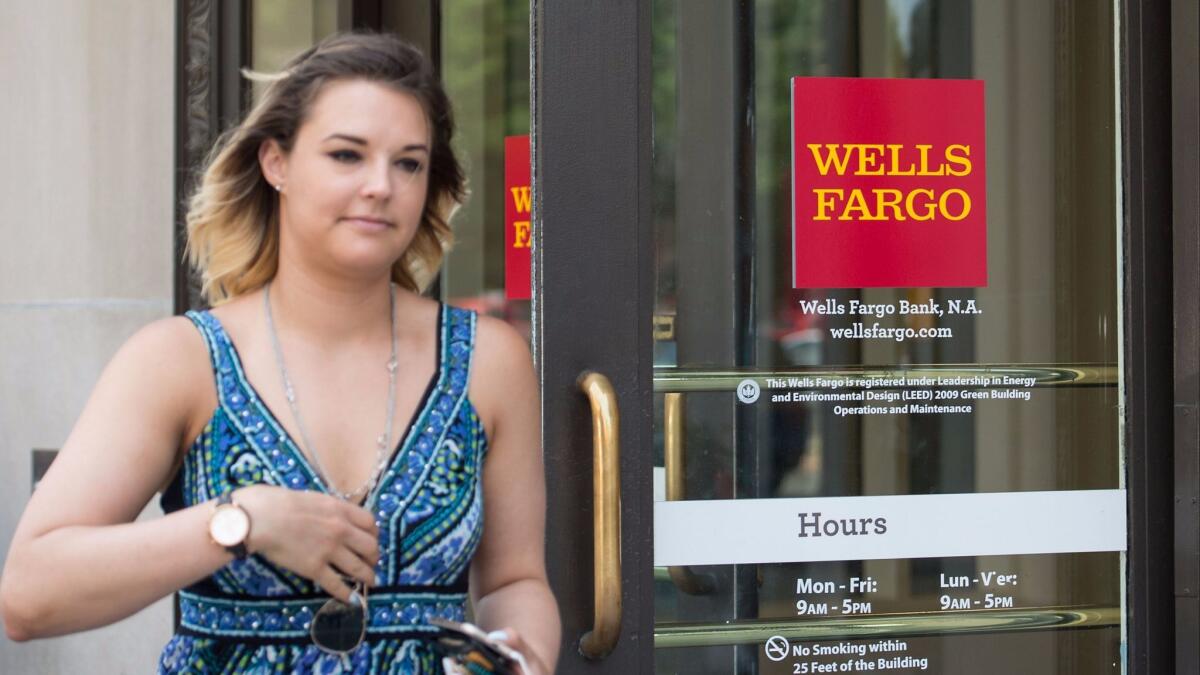Wells Fargo’s $110-million settlement is still not enough, lawyers say

Wells Fargo & Co. said Tuesday it would pay $110 million to settle a raft of consumer lawsuits over the bank’s unauthorized accounts scandal, but lawyers behind some of those cases are hoping to kill the deal and push for a bigger payout.
Calling the agreement both premature and far too small, these lawyers say they plan to formally object to the settlement and take whatever other actions they can to keep their own cases going — and perhaps reach a more lucrative deal with the bank.
“Our position is we’re moving forward however we can at this point,” said Steven Christensen, an attorney who filed a case against the bank in federal court in Utah last year. “We do not feel this settlement is a fair or adequate resolution.”
Opposition to the settlement could result in a range of outcomes, from a sweeter deal for Wells Fargo customers to no deal at all. Though the settlement was negotiated by one law firm representing a handful of clients who sued the bank in federal court in San Francisco, the deal would apply to Wells Fargo customers nationwide.
If the settlement is approved and finalized — a process that could take several months — only customers that opt out of the settlement would be able to continue legal action against the bank. Most consumers don’t opt out of settlements, so approval of the deal would probably have the effect of quashing nearly a dozen cases in other jurisdictions or severely limiting the number of customers who could participate in them.
The lawyers at Seattle firm Keller Rohrback who negotiated the Wells Fargo deal stand to get a big payout if this settlement is finalized, while attorneys in other cases are likely to get much less or nothing at all. But those attorneys say there are key legal issues at play too.
Christensen and others argue that Keller Rohrback had little leverage in negotiations with Wells Fargo because of an early ruling against the firm’s clients. In that case, U.S. District Judge Vince Chhabria decided in 2015 that plaintiffs Shahriar Jabbari and others could not sue the bank and must instead settle their disputes in private arbitration.
Wells Fargo argued, and Chhabria agreed, that the agreements customers sign when they open Wells Fargo accounts demand that customers resolve all disputes with the bank — even disputes over unauthorized accounts — in arbitration.
Although Wells Fargo has referenced Chhabria’s ruling in other courts, arguing that plaintiffs in other cases also should be forced to arbitrate, so far no other judge has issued such a ruling. Christopher Hood, a Birmingham, Ala., attorney who is representing clients in two federal cases against the bank, said it is telling that Wells Fargo chose to negotiate a settlement in the Jabbari case.
“There’s only one place that’s had that decision, and it turns out that’s the only place where Wells Fargo wants these cases settled,” Hood said. “We think that’s a little dubious.”
Alexandra Lahav, a law professor at the University of Connecticut who specializes in class actions and complex litigation, said that’s a legitimate concern.
“The potential that this plaintiff is willing to settle for less and that Wells Fargo can benefit from their relative disadvantage could be a concern for a judge,” she said.
Christensen and Hood say they believe there’s a chance their cases will be allowed to proceed and will not be sent to arbitration.
“We feel we would get a different result in Utah or another jurisdiction,” Christensen said.
Hood said the customer contracts signed by his clients — some of whom initially opened accounts at Wachovia, a bank acquired by Wells Fargo in 2008 — contain a different and somewhat more limited arbitration agreement than the ones signed by plaintiffs in the Jabbari case.
Hood said the differences in those arbitration clauses could be enough for a judge to allow his cases to move forward. And if the case is allowed to proceed, he said it could result in a ruling or settlement of much more than $110 million.
“We think we’re going to take a run at these guys,” he said.
Hood and Christensen also point out that none of the cases against Wells Fargo have made it to the discovery phase — the point at which the bank would have to turn over records and other evidence. With no discovery so far, attorneys say the scope of the bank’s wrongdoing is still unclear. For now, they’re relying only on numbers the bank has reported itself, based on a report from an outside auditing firm.
“Without discovery, no one can determine the extent of the damage Wells Fargo has caused,” Christensen said.
Wells Fargo in September agreed to pay $185 million in fines to regulators to settle investigations and a city of Los Angeles lawsuit over the creation of unauthorized accounts. The bank acknowledged that employees, 5,300 of whom were fired over the practice, created as many as 2.1 million unauthorized checking, savings and credit card accounts from 2011 to 2015.
It’s never been clear, though, how many of those accounts were actually unauthorized or how many customers were affected. The bank has pledged to repay fees that customers were charged for unauthorized accounts in their name and so far has paid $3.2 million to an undisclosed number of customers who hold about 130,000 accounts.
Lahav said settling before discovery is a cause for concern but a move that makes sense for Wells Fargo. It limits the risk that the institution might have to turn over additional, potentially damaging information, if a different judge allows a case to proceed. Settling now also puts consumer lawsuits to rest and could limit the amount of attention paid to the bank’s arbitration policy, which has been widely criticized and is the subject of proposed federal legislation.
One way to view the deal, Lahav said, is that Wells Fargo opted to settle a case in which it was already ahead rather than risk falling behind in other cases and possibly paying a bigger settlement later. The $110 million the bank has agreed to pay amounts to 0.5% of the bank’s 2016 profits.
“If they succeed in getting this settlement approved, all those other cases are off the table,” Lahav said. “Whatever rulings there might have been regarding arbitration will never happen. And if those cases are less good for Wells Fargo than this one, all the better for Wells Fargo.”
Of course, there’s a risk on the other side too. If other cases proceed and more judges rule that Wells Fargo customers must go to arbitration, the bank might decide it shouldn’t settle at all, though Wells Fargo said Tuesday the settlement is part of its effort to rebuild customer trust.
“Maybe this is the best settlement the plaintiffs can get,” Lahav said. “But the circumstances make you think it’s worth a hard look.”
Derek Loeser, one of the Keller Rohrback attorneys representing Jabbari, declined to comment beyond saying that “the arbitration clause was obviously central to this litigation and the resolution of it for all parties.”
Through a spokesman, Wells Fargo declined to comment further, noting that attorneys for the bank and plaintiffs are working on the preliminary settlement agreement that is expected to be submitted in the coming weeks.
The settlement plan will probably include an analysis of the risks and potential rewards for Wells Fargo customers in accepting this settlement rather than continuing to fight the bank in court.
It will also shed more light on key details of the settlement, including the amount of money the plaintiffs’ attorneys will ask for — often about 25% of the total payout, in this case $27.5 million — and how much the average Wells Fargo customer might get.
Follow me: @jrkoren
ALSO
In a giant leap for space industry, SpaceX successfully launches a recycled rocket
Virtual reality visionary Palmer Luckey leaves Facebook 3 years after $2-billion Oculus deal
Rival airlines poke fun at United over leggings dispute
More to Read
Inside the business of entertainment
The Wide Shot brings you news, analysis and insights on everything from streaming wars to production — and what it all means for the future.
You may occasionally receive promotional content from the Los Angeles Times.










